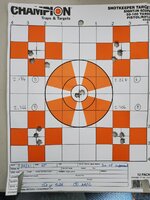- Messages
- 1,253
- Reactions
- 2,474
I shoot a lot of TSX bullets. Barnes says .030 to .070 off the rifling, I found .050 best in my guns. [ some are longer than that due to mag length].The bullet im using is a Nosler Partition, but Im also going to develope a load using a TTSX lead free bullet. I havent started that one yet and will need to do a pressure test first to work up the powder charge.
But when I first started using lead free there was not a lot of data available. I was trying to seat them like a lead based bullet up closer to the lands. What I got were erratic velocity and not much accuracy! Once I learned that solid copper needs a little jump to get started it got much easier.
I'll be honest with you. I would not use lead free if I were not forced by the state! They cost more for less performance.
Good Luck DR













